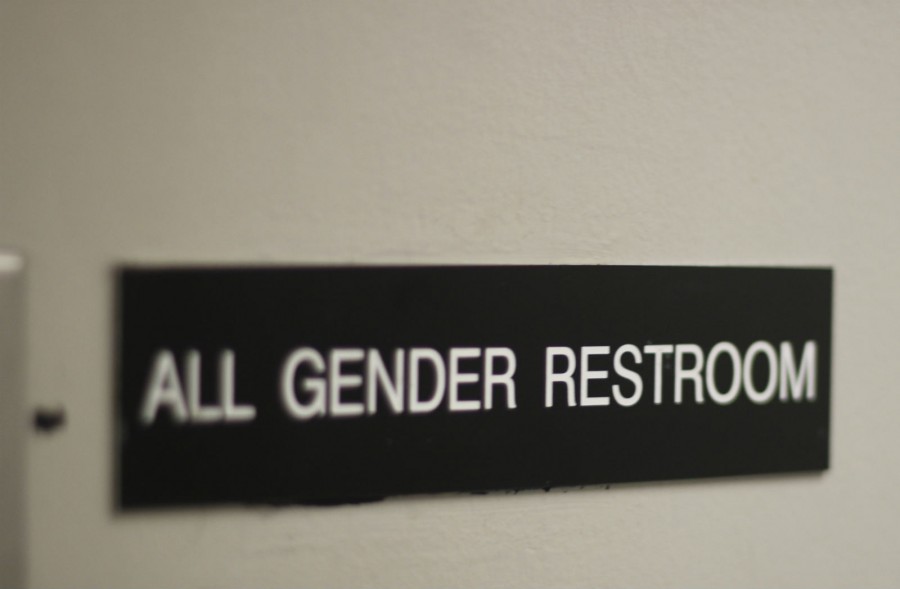DHS students push for gender-neutral bathrooms and locker rooms
Efforts to make school more inclusive for non-binary students in progress
The sign on the gender-inclusive restroom, located in P-Hall, that designates it open to people of all genders.
Only a few miles from DHS, in Palatine, a national news story is underway. District 211 refused to allow a transgender student to use the locker room that corresponded with her gender identity, which the U.S. Department of Education found to be a violation of anti-discrimination laws. This case captured the attention of people all over the country and made countless schools examine their own policies.
DHS policy does allow students to use facilities that match their identity, but for some students, who identify outside of the male-female gender binary, those facilities don’t currently exist. Non-binary DHS students, and their allies, are currently working with the administration to obtain more gender-neutral facilities, so that all students, regardless of gender identity, can have equal access to facilities many of us take for granted.
Starting at the beginning of this school year, various students have been working with the DHS and District 113 administration to create more gender-neutral bathrooms. They are also pushing for more private locker room areas and education for adults and students alike about issues related to gender. One student who has been heavily involved in these initiatives is junior Quin Perlow.
“We’ve talked a lot with teachers who are involved with Spectrum and Alliance and other staff members … We’ve had individual students who have been talking with the principal and the deans and Spectrum as a club met with the principal to talk about gender-neutral bathrooms and more private changing rooms.” Perlow said.
Perlow and other students have had numerous meetings with Principal Dignam, who plays a key role in this process. While students are usually the ones who are pushing for changes to be made, it is up to members of the DHS and District 113 administration to make sure these changes are safe and up to code.
“I work with our facilities personnel here and at the district office to make sure that when we are reviewing washrooms that we are in compliance with all state mandates and school code… a simple renovation of a small washroom is actually going to require ADA compliance and being within code, so sometimes it takes a little bit of time to ensure that the process is in place.” Dignam said.
Currently, there are only two gender-neutral bathrooms for DHS students to use, one tucked into an alcove in P-Hall and the other in A-Deck. These out-of the-way locations put strain on non-binary students, as it might take 10 or more minutes to get to the bathroom and back from certain halls. Changing for gym creates additional inconveniences. As there is currently no gender-neutral locker room, and very few private changing areas, non-binary and transgender students have to go to great lengths to change in a way that complies with both their gender identity and school policy. Junior Sorrel Rosin, who identifies as genderqueer, has experienced many of these difficulties.
“I had a lot of issues this year with being late to class and missing class, because I just had to go to the bathroom, and I think one of the hardest things this year was changing for gym because there’s two locker rooms, neither of which I fit into, and I was still required to get a locker in the locker room and it didn’t make sense to go to the locker room, grab my stuff, go back to the nurse’s office, change, bring my stuff back, relock it up, and I still had to go back into the place where I didn’t feel comfortable going into.” Rosin said.
Rosin has started her own initiative, called The Gender Neutral Project, which is separate from the DHS-specific initiatives, but deals with similar issues. The goal of this project is ultimately to create and distribute stickers that make spaces, such as public bathrooms, safer and inclusive of people of all gender identities. According to the Facebook page for this project, it’s “designed to spread awareness about all of the ways gender can be expressed.” Unfortunately, she has run into several issues with the public’s perception of her project.
“I think the biggest issue that I’ve come across is that, technically, my Kickstarter project is vandalism …also, it’s like, what happens when someone gets pissed off and takes down the sign and I give out these stickers for people to put up and they get in trouble for it, and it all comes back to me or someone else? I’m worried about people taking it the wrong way and taking it as vandalism, not as a public art project to raise awareness, which is what it is.” Rosin said.
In addition to supporting The Gender Neutral Project, there are a number of ways DHS students can get involved with this movement for equality. Staying on top of current events, such as the situation in District 211 and the changing laws in regards to gender identity and bathroom uses, and spreading accurate information are important parts of fostering awareness. Another part of being a good ally to transgender and nonbinary people, according to Perlow, is to be conscious of the language used when describing people’s genders.
“[The best ways to show support are] if you see the opportunity to be more inclusive in your language, to take it, and specifically with gender-neutral bathrooms … spreading information and awareness about why these things are needed is one of the best ways to stick up for transgender, nonbinary people.” Perlow said.
On a nationwide scale, laws regarding gender identity and bathroom use are very much in flux. For the most part, change in recent years has been positive, and many institutions, including DHS, are working to make bathrooms safe and accessible for people of any gender identity. However, in Houston, progress seems to be moving in the opposite direction. Voters there recently reject an LGBT anti-discrimination ordinance, because, according to the LA Times, they “contend the “bathroom ordinance” poses a public safety threat because it would allow transgender women into women’s restrooms.” For many, this kind of rhetoric signals a mindset that fosters hatred and violence towards transgender people.
“When you look at the numbers, there has never been a reported event of a trans woman sexually harassing anybody in a bathroom … it’s just like you’re not seeing these people as humans, you’re not seeing them as their actual gender, you’re just seeing them as sexual deviants which is really disheartening, because at the end of the day, everyone just wants to be respected for who they are” Perlow said.
Emma Pinsky is a senior and the managing editor of Deerprints. She joined Deerprints as a sophomore to pursue her interest in writing and it quickly became...












Ryan • Nov 30, 2015 at 8:01 pm
So happy to see my high school alma mater making progress on an important issue. I hope the administration keeps its word. High school is a difficult time for anyone, and the school should do what it must to ensure students are not marginalized.